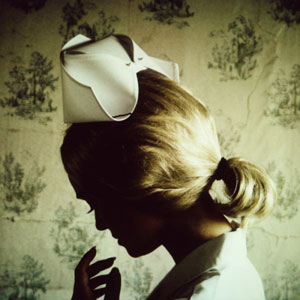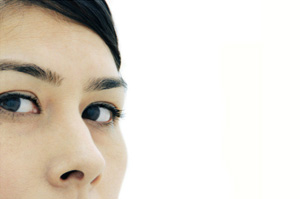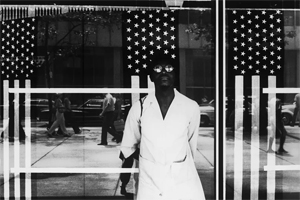Haunting Women
John Haberin New York City
Marianna Rothen and Barbara Probst
Ming Smith and Women Photographers
Images of women keep haunting art, and art keeps haunting images of women. Just ask women photographers.
When Marianna Rothen looks at herself on camera, she sees her shadow in paradise—meaning for her the far side of Hollywood. When Barbara Probst calls her work Exposures, she, too, is holding back. As for Ming Smith, is she a street photographer or a dreamer? It depends on what you mean by African American dreams and life on the street. All three look back to Postmodernism as a given, maybe even a thing of the past. Feminism may keep changing, but paradise is not coming soon enough. 
nth-generation feminist
Marianna Rothen is an nth-generation feminist. I would fill in the n, but by now I have lost count. Besides, her work is all about multiplicity. She and her friends pose in photos that dare one to pin them down or to tell them apart. One has seen them, for certain, somewhere before. It might have been in a theater, a video stream, a gallery, or a museum.
If that sounds all too familiar, it should. Her Shadows in Paradise riffs on an industry that depends on both darkness and dreams, the movies. In particular, Rothen explains, she draws on Ingmar Bergman's Persona, Robert Altman's Three Women, and David Lynch's Mulholland Drive. Like them, she stages a woman's dislocation, and the multiples add up. Altman himself, after all, drew for inspiration on Persona, and Lynch was remaking the glamour and melodrama of a Hollywood that had long gone. The psychological truth-telling and avant-garde stylization of Bergman in the 1960s and Altman in the 1970s, in fact, had done a great deal to chase it away.
Rothen moves in territory familiar from the 1980s as well—the "Pictures generation" of Cindy Sherman and Laurie Simmons. Sherman, of course, made her name by posing for Untitled Film Stills. And Simmons posed dolls for what could be a film perpetually in progress. Rothen, too, plays feminine roles, while looking so doll-like at time that I mistook her for a toy. Men, I suppose, do that sort of thing. So did Alfred Hitchcock and film noir.
Her technique, too, produces multiples while simulating a lost original. She works digitally in both color and black and white, before rephotographing prints as Polaroids for their pre-digital sheen—and then she scans them and prints them again. Her characters live in what her previous solo show called a "Pheromone Hotbox." They stare out windows or into mirrors, pose against old-fashioned wallpaper, nurse whiskey, lie dead, or hold a gun, in dated costumes and curls. They favor close-ups, strong contrasts, shallow depth of field, and unsettling camera angles. They play to expectations for an independent woman as vulnerable, desirable, and above all a threat.
Those expectations extended to a woman not often known for her regrets. Rothen also appears in video, on facing screens, as Woman with the Crown. Once again, strong lighting and old hairstyles make her a living doll. She takes on various roles while speaking the same text slightly out of synch, so that it appears to echo itself—generally once with emotion, the other flatly. The text, about a woman as sex object, turns out to quote an interview with Lady Di. Who knew that Diana felt so at a distance from the idol that she had become?
Of course, a fascination with Lady Di also goes back a ways. Is Rothen just late for the party or keeping it going? Is she upping the ante or viewing even feminism through the filter of today's hot fashion magazines? Is the nth degree a repetition or an extreme? Maybe both, but the seductions are real. Then, too, after the 2016 election, working out the generations of feminism matters as well.
Multiple exposures
Barbara Probst calls her photographs Exposures, but what exactly is she exposing? On one level, nothing at all, no more than for the women photographers in Foto-Cine Clube Bandeirante in Brazil decades before. A woman asleep cannot reveal her dreams—or even where she lies. Sinking past the bottom of her frame, she has no fixed relation to the rooftops in two more photos to either side. And they, too, hide their address somewhere unseen and below, the first both across the street and discomfortingly close, the second literally just letting off steam. The arrangement's very title, Exposure #115, hints at subjects long since multiplied into anonymity.
The façade at left appears unchanged in a series of five prints, to the left of a green shawl curtaining off whatever lies beyond. Then comes a still unfinished tower against the same blank gray sky. The woman, now awake and looking out a window, shows nothing but her back. Her face appears again in two rows of six photos each, twice without her eyes and once with little else. That leaves little more than a bottle in green glass, studio equipment, bare walls, and her hands on the back of a chair. Even the equipment seems cut off from its purpose.
 Then again, like Aneta Grzeszykowska or Marilyn Minter, Probst could be exposing her anxiety—or the viewer's. The woman seems calm enough, but her dark hair has swept up from her sleeping face, her eyes look everywhere and nowhere, and her hands have their restless, unsteady grip on the chair. Buildings corner-on allow no entry point or exit, not even in the zigzag of a fire escape, and the steam could be a metaphor for dark thoughts. They could be products of her dreams. One studio device looks both too fancy for a camera and way too dangerous. The entire series has the clinical lighting of a lab experiment or a horror film.
Then again, like Aneta Grzeszykowska or Marilyn Minter, Probst could be exposing her anxiety—or the viewer's. The woman seems calm enough, but her dark hair has swept up from her sleeping face, her eyes look everywhere and nowhere, and her hands have their restless, unsteady grip on the chair. Buildings corner-on allow no entry point or exit, not even in the zigzag of a fire escape, and the steam could be a metaphor for dark thoughts. They could be products of her dreams. One studio device looks both too fancy for a camera and way too dangerous. The entire series has the clinical lighting of a lab experiment or a horror film.
Of course, the lighting also typifies a studio. The woman has a model's beauty, and the curves of her eyes stand up easily to the near abstraction of a tripod's black diagonals against white walls. Her gaze evades and encounters the male gaze, much like the object of Jimmy Stewart's zoom lens in Rear Window. Probst's real subject could be photography's self-exposure, with the sitter and equipment on equal terms. That peculiar device connects multiple cameras for multiple exposures, triggered by a timer. Each work captures a single moment in time.
Still, it is a protracted moment, extending across sleep and wakening, not to mention across three works, three walls, and twenty frames. The rooftops and urban vistas recall another extended series of German photography, the water towers of Bernd and Hilla Becher. The wall grids and the studio's near emptiness relate as well to Minimalism, as with Carl Andre and his invitation to take one's time to explore the space around one. The focus on a medium and its making recall Minimalism, too, as with Frank Stella. Fragmenting a subject across the grid rather than as photo collage sets the series apart from Surrealism on the one hand and digital culture on the other. Anxiety here belongs neither to the present moment nor to the past.
Probst is both clinical and personal, down to the lines and curves echoing from frame to frame, like a woman's body for Hans Breder or Irving Penn. There may be something notably German, too, about the close-ups and crisp edges. As with Gerhard Richter and Richter's late work, she is both literal and self-reflexive. Still, the work now belongs to New York, where she spends much of her time. Like the woman at the window, a New Yorker knows how strangely time passes in a familiar but ever-changing landscape, between lonely rooms and crowded streets. In photography as in the city, exposure and reticence both have their place.
Dreams of the street
When it comes to street photography, should you count the Million Youth March in 1998? Ming Smith adopts the conventions of photojournalism for marchers with their raised fists, in a show called "Evidence," but a march takes place on the streets, too. She must have preferred a million youth to an electrifying leader anyway. Two seated women in their Amen Corner Sunday best in 1976 could almost be looking on, but that is not a protest sign in their hands. It is a fan bearing the images of children and dogs. Blacks do their window-shopping through a fence, much as for Gordon Parks, but Smith dwells as much on their curiosity as their exclusion. 
Should you count old-world charm? In 1974, half a century after Henri Cartier-Bresson and Brassaï took to the streets of Paris, Smith found a point of view that may have you mistaking the Luxembourg Gardens for a collage of café society. Trees seem to float in midair above their reflections in a pool, even as they dissolve in sunlight and shadow. That same uncanny control of focus turns a woman in Harlem into a glowing echo of jazz posters behind her. It turns a young adult dressed for action into the silhouette of Another Place and Time, against a wall whose very disrepair captures points of light.
Smith can always find glamour and mystery in the everyday, however far from or close to home. Kites look like cartoon creatures of the night, but they have somehow moved indoors. A woman in Senegal faces a stubborn wind, but it lends her billowing dress an artful echo of the tree arching overhead. Grace Jones at Studio 54 is magnetic enough, but then so is Smith posed as Josephine Baker and dressed for the night. Sun Ra is an eye-catcher in performance, too, in the glitter of the jazz musician's Afrofuturism. But they are more than just icons of blackness, and Brassaï, in a portrait, holds up as best an aging white can.
The photographer has been asking what counts as African American imagery since she came to New York fresh out of college, in 1973. She strolled right into the Kamoinge Workshop of black photographers, becoming its first woman—and was the first black woman photographer to enter the collection of Museum of Modern Art. More recently, museums have seen her as a political artist, in shows of "Pictures by Women," "Black Radical Women," "Soul of a Nation," and Race, Myth, Art, and Justice." Her solo show inaugurates a black woman's gallery, too, thirty-five years after Just Above Midtown. If that rarity has received its share of mainstream press, Nicola Vassell had been a director for two of the world's poshest dealers. But then Smith knows all about transcending insider and outsider, too.
She does it in the darkroom, just slightly displacing a Japanese hilltop in the clouds. The cut circle could be her lens and the displacement an eruption. Smoke from a steel mill looks tawdry by comparison. She experiments with color, and sure enough "red-hot jazz" is purple and red. She digs deep into memories, so that her aunt under a blanket becomes a mountain in the sun. With the rippling, translucent drapery over another window, The Window Overlooking Wheatland Street Was My First Dreaming Place.
Smith reserves the show's last week for portraits of the WNBA, mere cheerleading without the cheer, but she has at least one unquestioned example of street photography, which appeared in the Whitney's eye-opening survey of Kamoinge as well. A young black man stands with his back to a window bearing the Stars and Stripes and the street. His scornful glance has its counterpart in white America—and reflections off his dark glasses their counterpart in the stars. Horizontal stripes, not in the flag, cover the faces of passers-by and any hint of their race, but you know all the same. Is a line heading down to the picture's edge the usual division between sections of the sidewalk or a crutch for someone that the man in the foreground all but hides? A dreamer can always find something more.

Marianna Rothen ran at Steven Kasher through April 15, 2017, Barbara Probst at Murray Guy through February 20, 2016, and Ming Smith at Nicola Vassell through July 2, 2021. A related review takes up Ming Smith at MoMA,




